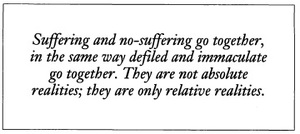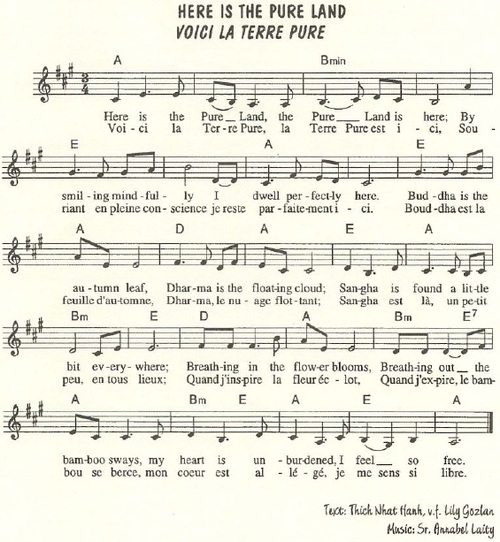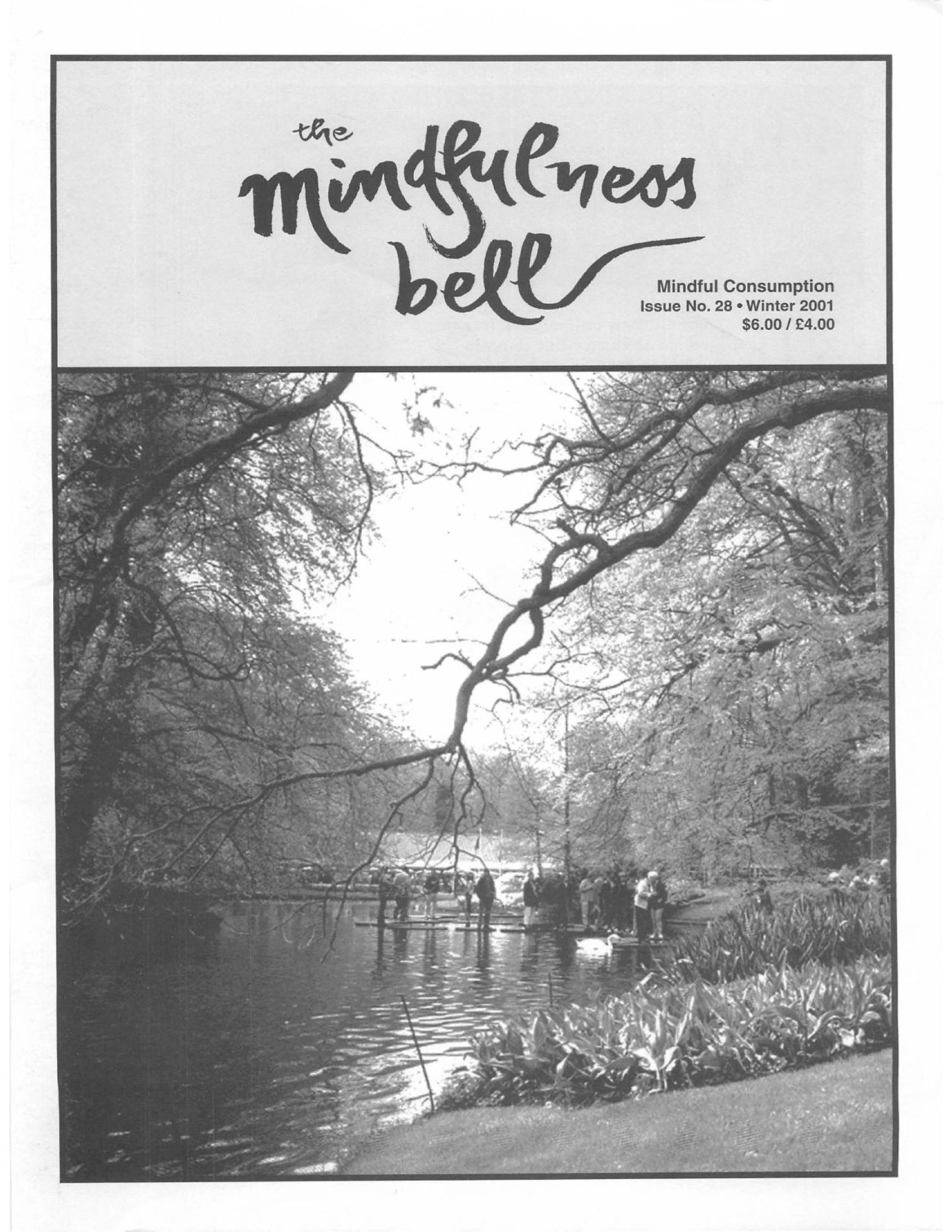By Sister Annabel Laity in January 2001
One day, Queen Vaidehi asked the Buddha, “Is the place with no suffering very far away?” The Buddha replied, “No, it is not far away.” And then the Buddha taught the queen how to touch the land of Great Happiness in her own heart and in her own mind.
We talk about “the Pure Land.” In Sanskrit, the word is “Sukhavati. “Sukha means happiness; vati
By Sister Annabel Laity in January 2001
One day, Queen Vaidehi asked the Buddha, "Is the place with no suffering very far away?" The Buddha replied, "No, it is not far away." And then the Buddha taught the queen how to touch the land of Great Happiness in her own heart and in her own mind.
We talk about "the Pure Land." In Sanskrit, the word is "Sukhavati. "Sukha means happiness; vati means having: "The Place Which Has Happiness." In the Chinese tradition, it is translated as the Pure Land, perhaps because of the nature of the writings about that place. These writings put us in touch with things we call pure. The Prajnaparamita writings were probably composed round about the same time as the Pure Land writing, and they say "No defiled, no immaculate." And yet we talk about the Pure Land in Buddhism.
In the Pure Land, there are many kinds of wonderful birds. Let us think about a bird. The bird's song sounds very pure, very beautiful. But we know the bird has to eat, and the food that the bird eats has waste matter, which we would consider impure. The sutra doesn't tell us whether birds in the Pure Land eat or not. But if they do, there must be bird droppings in the Pure Land, which means that the Pure Land wouldn't be quite so pure. Perhaps that is why the people who composed the Heart of the Prajnaparamita say, "No defiled" and "No immaculate." We know that if there isn't defiled, there can't be immaculate.
To understand the teachings of the Pure Land, we need to understand about Buddhist psychology. We need to understand that the store consciousness contains all the seeds-seeds of purity and impurity, seeds of happiness and suffering. We need to learn skillful ways of touching the seeds of happiness and purity in us, particularly when we feel overwhelmed by impurity and suffering. The Buddha and other spiritual ancestral teachers have helped us find ways to touch the seeds of purity.
The Buddha gave teachings about places where there was a lot of happiness. He sometimes pointed to a city like Kushinagara, the city where the Buddha later passed away, and said that in former times, this place was a place of great happiness. He would describe how the people lived there in a lot of happiness. Probably some ancestral teacher put together the Sukhavati Sutras based on some of the things the Buddha had said about lands of great happiness.
The Sukhavati Sutras and the Avatamsaka Sutra may seem very strange when we read for the first time. We read descriptions of trees that have jewels for their leaves, flowers, and fruit, and descriptions of water with eight virtuous qualities- clarity, sweetness, purity, coolness, limpidity, etc. These descriptions are not for us to consider intellectually. We do not read the Pure Land Sutras or the Avatamsaka Sutra with an intellectual mind. But when we read them, the descriptions touch the seeds of purity in us. For instance, we do not see leaves of jewels on the trees here. In autumn, the leaves here fall to the earth, decompose, and become one with the Earth again, whereas, a jewel doesn't decompose. But actually, if we look deeply into it, a jewel comes from decomposed material, because the mineral realms are also made up of the plant realms. When we walk among the trees in the autumn on this planet Earth, we see the beautiful red and yellow colors like jewels shining in the sunlight. But sometimes, we don't bring our mind to the presence of the trees, because we are lost in our worries or regrets. When we have been reading the Pure Land Sutras on a regular basis, then something in the depth of our consciousness knows that a tree is very precious, as precious as the most precious jewels. So whenever we meet a tree in mindfulness, we remember that it is precious, and we can be there with it in the present moment. And when we are really there in the present moment, we are already in the Pure Land.
There are different levels of belief in the Pure Land, and the highest level of Pure Land teaching is that your mind is the Pure Land, the Pure Land is available in your mind. The ancestral teachers put together the Pure Land Sutras with a kind of wisdom that helps us be in touch, and helps us to have the deep aspiration to be in a Pure Land and also, to help to build a Pure Land.
In Plum Village, we often have to write assignments for Thay. One year, Thay gave us the assignment to write about the Pure Land that we wanted to be part of. He told us to give a very clear description. What kind of trees would be there? What kind of activities would there be? Everybody wrote about a slightly different Pure Land, so we know that there are hundreds of thousands of Pure Lands. In each of our minds, there is the Pure Land, and we can go about establishing the Pure Land. You may like to write about this also. It's a very enjoyable assignment.
When we think about our own Pure Land, we have to come back to Queen Vaidehi's question. "Lord Buddha, is there a place where there is no suffering?" Out of compassion, the Buddha said, "Yes, there is." Queen Vaidehi's heartfelt aspiration to be in that place of no suffering came about because she had suffered so much. If she hadn't suffered, the idea of a place where there is no suffering would never have occurred to her. So suffering and no-suffering go together, in the same way defiled and immaculate go together. They are not absolute realities; they are only relative realities. And sometimes the Buddha has to teach the relative truth in order to be compassionate, to help, and to encourage. And that is why the Buddha said there is a place where there is no suffering.
But we know that Queen Vaidehi would also want to help those who are suffering. In the Pure Land, we have many bodhisattvas. The great joy of being in the Pure Land is that we are near many bodhisattvas. And if a bodhisattva wants to help those who are suffering, there must be people who are suffering. Therefore, in the Pure Land, there are people who are suffering for us to help. When we wrote about our Pure Land in Plum Village, many of us wrote about how the bodhisattvas helped others. One person even had a hospital in the Pure Land.

When you come to a Dharma talk, you feel very happy. Maybe you feel you are most happy when you are sitting and listening to the Dharma, because the Dharma is deep and lovely. It is beautiful in the beginning, it is beautiful in the middle, and beautiful at the end. In the Sukhavati Sutra, they say that in the Pure Land, you are always hearing teaching of the Dharma. But you don't just hear the Buddha Amitabha- the Buddha Of Limitless Light, the Buddha who founded the Pure Land. You don't just hear him giving teachings. You hear the birds giving teachings, you hear the trees giving teachings. Every time the wind rustles in the trees, that is a teaching of the Dharma; and every time the birds sing, that is a teaching of the Dharma. And when the people hear the wind rustling in the tree, they stop and remember the Four Establishments of Mindfulness, the Seven Factors of Awakening, the Noble Eightfold Path, and the other teachings of the Buddha.
There is a song written by Thay in Vietnamese, and then translated into English and put to music: "Here Is the Pure Land." I practice this song when I do jogging meditation. If I sing it in Vietnamese, then every syllable is one footstep. And I can also sing it in English and jog at the same time. It's very wonderful to be jogging in the Pure Land.
The first words of the song are "Here is the Pure Land." And the second sentence is "The Pure Land is here." This is in the tradition of the ancestral teachers. "Form is emptiness, emptiness is form." We say things twice like that because our consciousness receives the first word of a sentence as the most important word. So if we just said, "Form is emptiness," our mind concentrates more on the word "form" than it does on "emptiness." So we then say "Emptiness is form," so our mind is equally concentrated on form and emptiness. In the same way, if we say "Here is the Pure Land," our mind is more concentrated on the word "here." And if we say "The Pure Land is here," our mind is more concentrated on "the Pure Land." So the words of the song allow us to be concentrated on both.
Watering the seeds of purity in our store consciousness helps establish a good balance between purity and impurity. We have the tendency sometimes to look on everything as being impure and we need to put the balance right. We practice watering the seeds of happiness for the same reason. We have the tendency to look on the planet Earth as a place of suffering, and we need to put the balance right by seeing the happiness also.
When the Buddha taught Queen Vaidehi, she asked him "If the Pure Land is not very far away, if it's right here, how do I practice to be there?" The Buddha gave her a guided meditation in which she could touch the Pure Land. It's a little bit like the guided meditation "Breathing in, I am a flower; Breathing out, I feel fresh." He taught her to be in touch with the lotus flower in her own consciousness, the lotus flower blooming. He taught her to be in touch with the lake of the most clear, sweet water in her consciousness. In that way, she could begin by touching the seeds of happiness in her own consciousness. Then, when she was outside, walking in nature, she would also touch that world and feel happy.
Each of us has the capacity to build Pure Land a little bit in their own home, or by building a practice center, or by joining a practice center, or in their local Sangha. The local Sangha where we only meet each other once a week, or perhaps a bit more, is also a place where we can build Pure Land together. We can decide what kind of environment we can make. How can we arrange the sitting meditation hall in order to water the seeds of Right Attention in everyone who comes into the meditation hall?
The idea of attention in Buddhist psychology is quite important. It's called manaskara in Sanskrit, and is one of the 51 mental formations. It's one of the first five mental formations, which we call "the universal mental formations." Universal means that they are always occurring, they're always there. We are always giving our attention to something. We know that we can give our attention in an appropriate way, or we can give our attention to what is inappropriate. So we have Appropriate Attention and Inappropriate Attention.
When we go into the town or turn on the television, we need to be very careful what we give our attention to. You may see newspapers with words and images on them, and even though you don't stop to read them, if you give your attention to them, they can sometimes water the seeds in your consciousness that are not altogether wholesome. All kinds of information can flow into our consciousness through our eyes and our ears. We don't have to intentionally receive that information; it may still flow in. This is the meaning of universal mental formation (sarvatiaga); it is happening all the time.
So, we should make our environment a place where everything surrounding us helps nurture the best, the most refreshing things in us, things that can make us and other people happy. We can all do a little bit of this work-in our garden, in our home, in our school, in the place where we work. This is part of making a Pure Land.
Sister Annabel Laity is the Abbess of Maple Forest Monastery and Green Mountain Dharma Center in Hartland-Four Corners, Vermont. This article is excerpted from a Dharma talk she gave in San Diego, California in September 2000.



